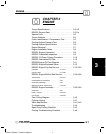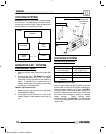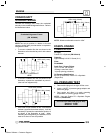
ENGINE
3.6
COOLING SYSTEM
W ARNING: Never remove radiator cap when engine
is warm or hot. The cooling system is under pressure
and serious burns may result. Allow the engine and
cooling system to cool before servicing.
Radiator
Thermostat
Cylinder
Head
Water
Pump
Cylinder
FLOW
RADIATOR CAP / SYSTEM
PRESSURE
TEST
1. Remove recovery bottle hose from coolant filler
neck.
2. Connect a Mity Vact (PN 2870975) to radiator
and pressurize system to 10 PSI. The system
must retain 10 lbs of pressure for five minutes or
longer. If pressure loss is evident within five
minutes, check radiator, all cooling system hoses
and clamps, or water pump seal.
Radiator Cap Pressure Test
1. Remove radiator cap and test using a cap tester
(commercially available).
2. The radiator cap relief pressure is 13 psi. for all
models. Replace if cap releases at less than 13
psi.
Pressure test
here with cap
in place
Coolant Flow
Diagram
Sensor
From Thermostat
To Wat er pump
COOLING SYSTEM
SPECIFICA
TIONS
Description Temperature
Fan Switch (Off)
Fan Switch (On)
150q F(65q C) r 8q
180q F(82q C) r 7q
Hot Light On 221q F (105q C)
System Capacity 2.25 Quarts (2.1 L)
Radiator Cap Relief
Pressure
13 PSI
RECOMMENDED COOLANT
Use only high quality antifreeze/coolant mixed with
distilled water in a 50/50 or 60/40 ratio, depending on
freeze protection required in your area. CAUTION:
Using tap water in the cooling system will lead to a
buildup of deposits which may restrict coolant flow
and reduce heat dissipation, resulting in possible
engine damage. Polaris Premium 60/40
Antifreeze/Coolant (PN 2871323) is recommended
for use in all cooling systems and comes pre-mixed,
ready to use.
Enfocus Software - Customer Support


















